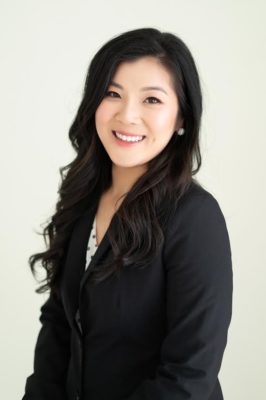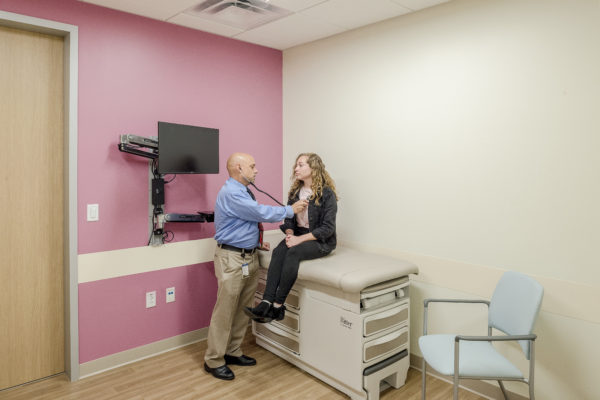As a pediatric psychologist, Dr. Jina Jang spends her work days supporting children who are receiving care at the Thompson Autism and Neurodevelopmental and Neurodevelopmental Center at CHOC, a centralized place for children to receive early diagnosis, advanced therapy and the possibility to reach their full potential.

Follow along for a day in the life of Dr. Jang
6:45 a.m. – If my alarm goes off before my 2-year-old wakes me up, it’s a lucky day. I get ready, feed my dog, and ensure my kid’s bag is ready for daycare. I go over my daily schedule with my mother, who helps with daycare drop-offs. If I have time, I usually stop by a coffee shop to pick up some much-needed caffeine.
8:15 a.m. – I arrive at the Thompson Autism and Neurodevelopmental and Neurodevelopmental Center at CHOC before my first patient is scheduled and quickly check messages and emails. On days that I arrive a little earlier, I will usually sit for a few minutes to admire the beautiful artwork throughout the center. A bubble theme is woven throughout the center’s artwork, and CHOC’s mascot, Choco Bear, is even hiding in a few of the bubble images. This artwork was among the many special considerations made when the center was being built. The center is designed throughout to ensure sensory experiences and transitions, lighting, stimulation spaces, signage and artwork are best suited for people with autism spectrum disorder (ASD).

8:30 a.m. – My first patient arrives for an in-person evaluation. Today, we have a patient who was referred by their pediatrician for an ASD evaluation. We had an intake session via telehealth yesterday. This is a new hybrid appointment model designed to help limit in-person contact as much as possible during the COVID-19 crisis, but ensure we still see patients who need in-person testing. This morning, we will conduct testing to assess the child’s overall developmental functioning. We will also assess for symptoms of ASD using standardized observation and interaction.
10:30 a.m. – I have a phone consultation with one of my patients’ applied behavior analysis (ABA) therapists. Children with ASD often have many different care providers and it is important for us to work closely with them to ensure collaborative care with continuity and compassion.
11:30 a.m. – I conduct a therapy session via telehealth with a patient as part of the center’s co-occurring conditions program. Children with ASD often have other medical conditions as well, and this program helps patients get all the care they need in one visit. I am co-treating this patient with Dr. Jonathan Megerian, a pediatric neurologist and the Center’s medical director. Having all providers at one visit not only reduces the amount of stress and other barriers for our patients, but it also allows us providers to map out the best treatment plan for our patients.

12:30 p.m. – Time for lunch! Before the pandemic, I would go out to lunch with my colleagues or pick up takeout for us to eat together. These days, I usually just eat alone in my office. Dr. Megerian is usually my lunch buddy. He is not only a great mentor but a fun friend. He has guided our team every step of the way, providing invaluable guidance and advice. I feel truly blessed to have such an amazing work family. Although we can’t share a meal in the same room due to physical distancing precautions, we still try to get lunch together. Today, he picked us up chicken sandwiches from a restaurant next door.
1 p.m. – When I have some time between appointments, I catch up on notes and review reports from my psychology trainees to provide feedback. The trainees are pursuing post-doctoral fellowships and honing their training and education to work with children with ASD in the future.
1:30 p.m. – I have a meeting with the team. Today, we evaluated our current assessment flow with the entire team, including our wonderful medical assistants, nurses, resource specialists and social workers. As a new center, it is important for us to continuously evaluate our clinic flows and assess what is working and what needs to change. Also, I am in communication with the entire team, which also includes other psychologists and financial coordinators, all throughout the day.
2 p.m. – Now I’m meeting with our assessment team about the young patient I met with earlier today. After meeting with the psychology team, this patient and family also met with one of our developmental behavioral pediatricians and also had speech and occupational therapy evaluations. Our amazing child life specialist helped ease any fear or anxiety the child and family may have felt throughout their appointment. The purpose of this team meeting is to discuss test results and diagnostic impressions, and make recommendations as a multidisciplinary team.
2:30 p.m. – Next, we meet with the patient’s family to provide feedback. As a team, we typically provide feedback on the same day as assessment. This child received a diagnosis of autism and global developmental delay. It is never easy to be the first ones to tell a parent that their child has developmental delays. However, our goal is to provide families with comprehensive testing results and treatment recommendations without a delay. We understand that this new diagnosis may be overwhelming and stressful for our families. After a diagnosis, they get connected with our social workers and personal service coordinator to continue support with additional resources.

3 p.m. – On to another therapy session. Now, it’s a patient with ASD, attention deficit hyperactivity disorder, and sleep difficulties. For this patient, we created some tools and systems to help.
Many of our patients and families have experienced disruptions to their daily routines due to the COVID-19 pandemic. It’s crucial that we help families and children cope with disrupted routines; establish “new” routines; teach “new” norms like wearing masks and keeping distance; and teach families strategies to manage any increased challenging behaviors.
4 p.m. – My last session is a follow-up meeting with a patient with ASD who is also experiencing separation anxiety. We have been working on exposing the child to small, controlled moments of separation with hopes that will reduce anxiety over time.
4:30 p.m. – I have a one-on-one meeting with Matthew Lazari, the center’s executive director. My check-in meetings with Matt usually involve picking his innovative and smart brain to address any challenges we might have. Today, we talk about screening candidates for a new psychologist position.
5 p.m. – I send messages to patients through CHOC Link, a portal for CHOC patients and families to communicate with caregivers. I also check emails and check my schedule for tomorrow. With that, I say goodbye to my colleagues and head home to my family.




